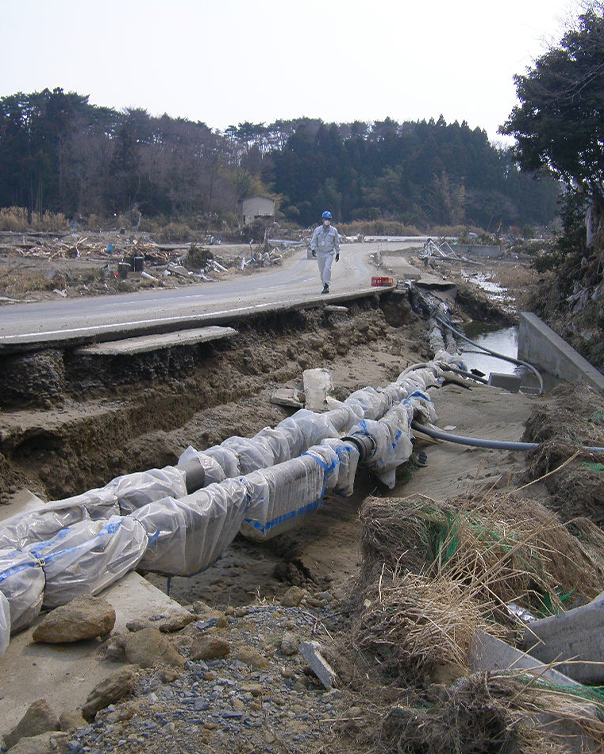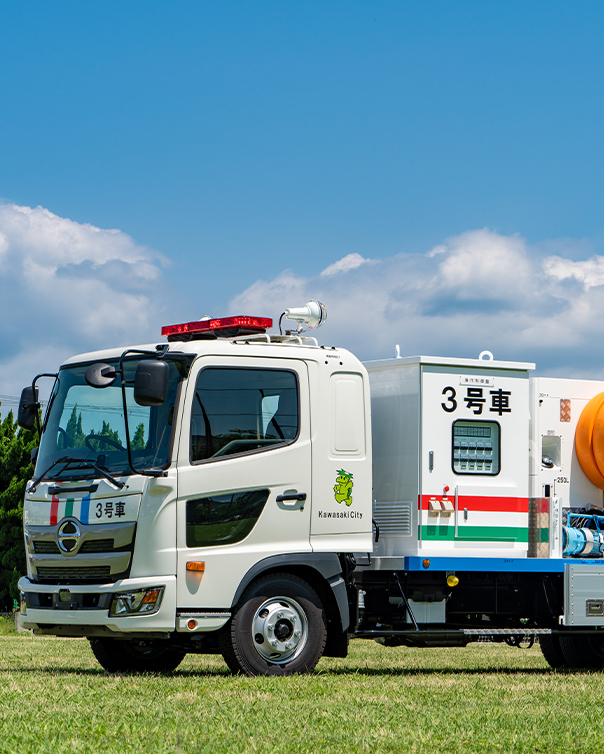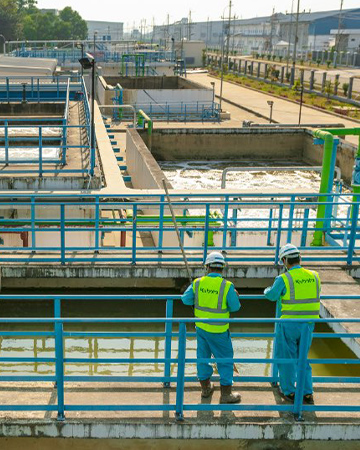
From major earthquakes such as the 1995 Great Hanshin-Awaji Earthquake to typhoons and torrential rains, Japan has been repeatedly hit by a number of record-breaking natural disasters. Local governments are preparing evacuation shelters at a rapid clip, but one of the most important aspects of these facilities is emergency toilets. That is because when a major disaster occurs, power outages and water stoppages can make it impossible to use the flush toilets we all take for granted.
Emergency toilets can be categorized into four main types: portable toilets and simple toilets for indoor use, and makeshift toilets and manhole toilets for outdoor use. Makeshift toilets are frequently used at construction sites and at fireworks festivals and other events, but the hassle of securing the required number of toilets and the time required to transport them can present challenges in the event of a disaster. One type of toilet that is now attracting attention is manhole toilets, which consist of simple toilet bowls and private tents affixed to the manholes over sewer pipelines. These can be set up quickly to provide toilet functions. In this article, we will take a closer look at the convenience and potential of manhole toilets.
Toilet Troubles During Disasters Can Lead to Health Hazards
Japan Toilet Labo, a non-profit organization, conducted a survey in the areas affected by the 2011 Great East Japan Earthquake. When asked within how many hours they needed to use the toilet after the earthquake, nearly 70% of respondents answered, "Within six hours." Another survey in the areas affected by the Great Hanshin-Awaji Earthquake asked, "What things do you need now?" "A toilet" was the most common response. This shows that in times of disaster, the need for emergency toilets comes before the need for food and water. "Another issue is that only 34% of municipalities had makeshift toilets available at evacuation shelters within three days of the Great East Japan Earthquake," said Atsushi Kato, chairman of Japan Toilet Labo.
People at evacuation shelters after the Great Hanshin-Awaji Earthquake were asked, “What do you need now?”
| January 20 | January 21 | January 22 |
|---|---|---|
| 1.Toilets | 1.Toilets | 1.Underwear |
| 2.Blankets | 2.Underwear | 2.Medicine |
| 3.Medicine | 3.Medicine | 3.Toilets |
| 4.Sanitary products | 4.Tents, sheets, etc. | 4.Tents, sheets, etc. |
| 5.Diapers | 5.Diapers | 5.Heating equipment |
Nihon Keizai Shimbun, January 24, 1995
Even if people can do without food and water to some extent, they cannot do without the use of toilets. “In some past disasters, people faced difficulty using toilets due to poor sanitation, lack of lighting, difficulty of use, and other factors,” says Kato. “Some people cut back on fluids to reduce their toilet use, leading to dehydration. There were also reports of people suffering from vein clots in their lower limbs.” Toilet-related issues during disasters can not only lead to mental stress, but also physical health problems, which can be life-threatening.

Manhole Toilets Designed for Simplicity and Ease of Use
Of course, makeshift toilets are not always unsanitary. When operated properly, they can be used hygienically. But the need to transport them to evacuation shelters from other locations means that delays in setting them up are inevitable due to road conditions and other factors caused by disasters. “The uncertainty about how many toilets can be provided is also a cause for concern during disasters,” explains Kato. “In this regard, manhole toilets can be used instantly if they are prepared in advance, simply by removing the manhole cover and placing a toilet bowl and private tent over the hole.”

Kubota (now Kubota ChemiX) began developing manhole toilets in 2001. This move was inspired by requests from local governments who sensed inconvenience in the manhole toilets being used at the time – “They are unsanitary because water collects in them,” “Their structure is difficult to understand,” and “Their components are too expensive.” The engineers at the time took those requests and came up with a basic concept by making them flushable, giving them a simple structure connecting a small diameter manholes with ribs to the sewer line, and other features. In 2002 they conducted large-scale experiments to test the flow of the system. Later they developed a flushing unit with a water gate to improve cleanliness and operability during actual use, and in 2009 they began selling the Manhole Emergency Toilet System (Direct Connection Type) in its current form.

Yukihiko Saito of Kubota ChemiX explains the development project's success as follows. “The Kubota Group's long history of pipeline technologies and expertise as a manufacturer of water and sewage pipes made this system possible, and this is our advantage. Also, Higashi-Matsushima city in Miyagi Prefecture adopted this directly-connected Manhole Emergency Toilet System as a measure to prepare for large-scale earthquakes.”

“After the Niigata-Chuetsu Earthquake in 2004, Higashi-Matsushima city officials who rushed in to help noticed the problems with toilets in evacuation shelters," recalls Saito. "This led to the decision to set up manhole toilets. They gave high marks to the hygienic aspects and ease of operation of the emergency toilet piping system we recommended, and work on the system began in 2009. I have heard that the work was completed in five of the city's 16 designated evacuation shelters in December before the Great East Japan Earthquake. The client told me, 'We talked about when we would ever have to use this system. Then a major earthquake hit just three months later, and we were able to put the system to use.' Hearing this made me very grateful that our manhole toilets were useful.”
Low-cost, Compact: Ease of Installation and Operation Provide Advantages
Currently, Kubota ChemiX's emergency toilet piping systems are available in two types. In addition to the directly-connected model, there is also a directly-connected and storage tank model that functions to store up to three days' worth of liquid waste and cleaning water.

The piping system uses a type of polyvinyl chloride (PVC) pipe called pipes with ribs, which are manufactured in-house by Kubota ChemiX. Sand is typically used when burying PVC pipes, but in an earthquake the vibration could lead to liquefaction, which can cause the pipes to rise out of the ground. The unique structure of the pipes with ribs allows them to be buried under crushed stone, enabling the building of liquefaction-resistant pipelines.


These images show the simple structure in the buried portion of the pipeline, which has pipes with ribs arranged in straight lines.
Yasutaka Matsuo of Kubota ChemiX explains the advantages of the company's system. “pipes with ribs and small diameter manholes with ribs are not exclusive to this system. They are widely used in piping for general sewer systems, and they are outstanding in terms of economy. The small diameter of the pipes and their light weight and compactness are features that help to keep maintenance costs down.”

To flush away the waste, a certain amount of pool water or well water is stored in the cleaning unit's tank using a hand pump, and the water gate opens periodically to flush the water through the pipeline. It's worth noting that the hand pump does not require much force, so people using manhole toilets in disaster areas can easily operate it themselves.
Working During Normal Times to Publicize the Benefits of Manhole Toilets
Guidelines from the Ministry of Land, Infrastructure, Transport and Tourism state that one manhole toilet is required for every 50 to 100 people. However, as of fiscal 2017 there were only 30,000 manhole toilets available throughout Japan, which is insufficient for current needs. Kato points out that lack of awareness is one of the factors behind the slow progress in development. “In terms of disaster preparedness, the Disaster Prevention, Crisis Management, and Parks Divisions of local governments, as well as the boards of education in the areas of evacuation sites, are responsible for taking measures. The convenience of manhole toilets is not yet known among these parties. The same is true with the general public. Because people do not know about them, they have no expectations for them. Therefore, I think one way to make people more aware of manhole toilets is to increase the number of events and other occasions people can use them during non-disaster times.”
One effort to increase this awareness was the use of the Kubota ChemiX Manhole Emergency Toilet System to provide temporary toilets at a cherry blossom festival held in Kinshi Park in Sumida Ward, Tokyo, in 2017. “The project began in 2011 when ten manhole toilets were put in to prepare for disasters, and we were approached by a representative of the ward's Road and Parks Section to inquire about their use,” says Saito. “A cherry blossom festival is held every year at Kinshi Park, and two vault-type makeshift toilets were set up for use. However, lots of complaints came in that the toilets would quickly get filled up and become unusable, or that they were unclean. As one solution to these problems, we worked with a major rental equipment manufacturer and suggested manhole toilets using makeshift toilets, which were eventually adopted. Because they had pre-installed water supply pipes, they could flush with water and be used like normal toilets. There were no complaints from users, and since the toilets were directly connected to sewer pipes, there was no issue with capacity restrictions preventing their use. I think these advantages should be used to promote them.”

The benefits of using manhole toilets during non-disaster times go beyond raising awareness. This also provides practical training for their use. And it helps officials ascertain various needs, such as a place for users to put a bag or color-coding for men's and women's restrooms. Incorporating these needs in emergency toilets could help to alleviate some of the stress during disasters, which place huge physical and mental burdens on people.
Manhole Toilets Should Offer the Peace of Mind of Regular Toilets
When a disaster strikes, not being able to use the flush toilets we are accustomed to can cause stress. Therefore, one thing that people expect of manhole toilets is high quality. For example, they should have a sturdy and secure private space, and they should be well-lit for use at night. The capability to provide a full-fledged toilet environment that is equivalent to what people use during normal times is the advantage of manhole toilets.
“With manhole toilets, we are responsible for the underground part, and we have confidence in our technology and know-how related to the piping that is used,” says Yoichi Murase of Kubota ChemiX about the future prospects for the systems. “We will continue to develop products in order to provide total solutions including the upper fixtures such as private tents, toilet bowls, and nighttime lighting, so that we can contribute to the creation of safe and reassuring toilet environments.”

In times of disaster, emergency toilets have to be provided at evacuation shelters before even food and water. Kubota ChemiX has developed its Manhole Emergency Toilet System as an effective solution, and it has been suggesting the installation of manhole toilets to local governments and other parties. The system was put into operation just 20 days after the Great East Japan Earthquake in Higashi-Matsushima City, Miyagi Prefecture. It earned high marks for its convenience, especially for maintaining cleanliness, and has gradually spread to other local governments as well as housing complexes and other facilities throughout Japan.
If the use of manhole toilets can spread so that they become standard equipment for disaster preparedness, they could reduce stress during times of crisis, and also alleviate health hazards that result from people's reluctance to use the toilet. Kubota is working to continue its progress on manhole toilets so that they become high-quality services with all of the convenience and peace of mind people expect from everyday toilets, and to promote their use as a disaster preparation measure with benefit for society.



